IN THE MOUTH OF MADNESS (1994)
An insurance investigator visits a small town while looking into the disappearance of a popular horror novelist.
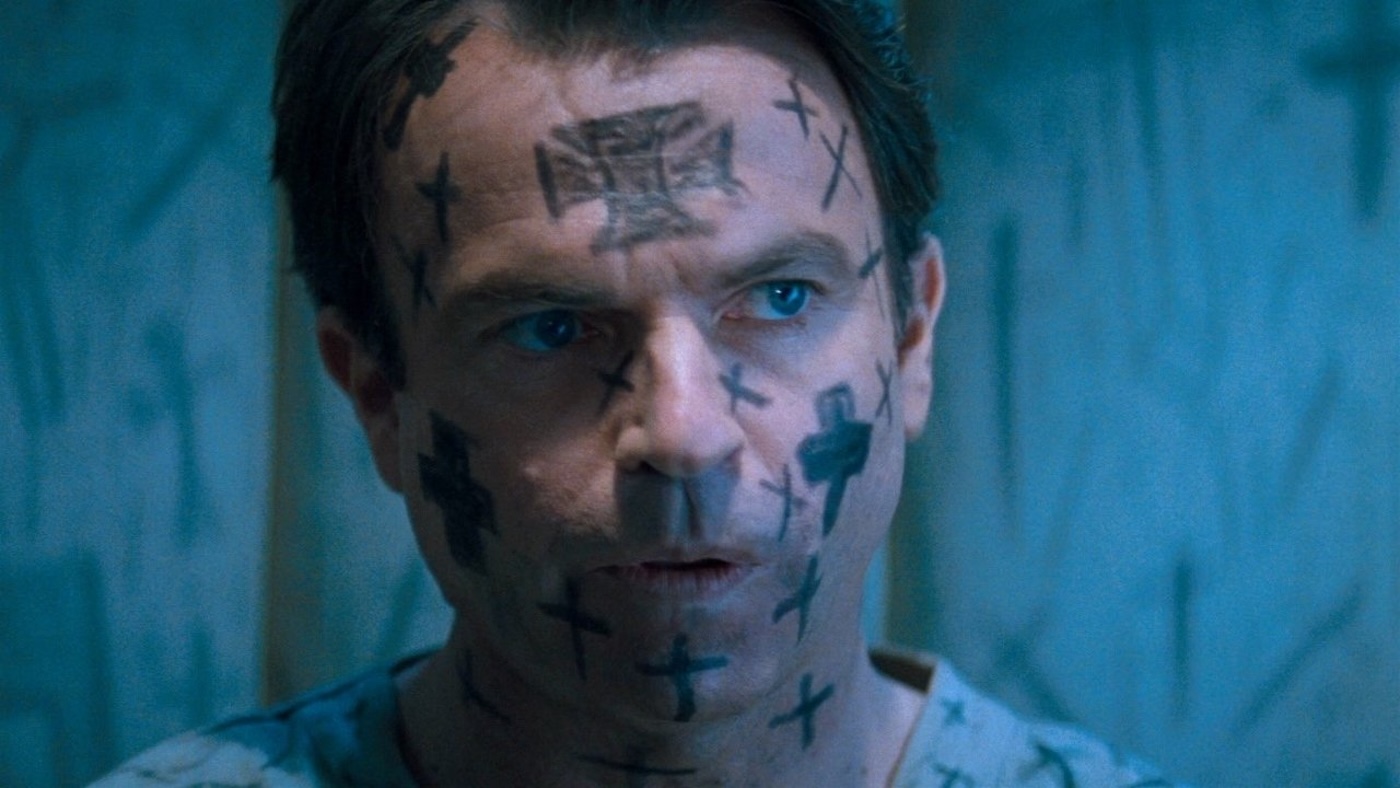
An insurance investigator visits a small town while looking into the disappearance of a popular horror novelist.


As a major fan of horror films, John Carpenter is one of my favourite directors. In fact, I’m sure Halloween (1978) is the reason I became hooked on this genre. There I was, aged only 12, having a sleepover at a mate’s house, circa 1984, and we chanced upon the first outing of one Michael Myers. Even though we were only watching it on a small black-and-white TV, the effect it had on me was nothing short of life-changing. I was left terrified, but I still came away hugely entertained, and even before the end credits had finished, I knew I’d seen something special. Fairly soon after, my lifelong addiction for all things macabre and ghoulish committed to celluloid had been born.
Aside from Halloween, I would have to list The Fog (1980) and The Thing (1982) as my favourite Carpenter films. These are, for me anyway, some of the finest examples of movies that consistently convey a sense of dread and suspense, while at the same time delivering genuinely scary moments, great special effects, superb soundtracks—and the cinematography on both is first-rate too.
Unfortunately, despite his many filmmaking successes, Carpenter has also been guilty of churning out several duds: Memoirs of an Invisible Man (1992) and Escape from L.A. (1996) must surely tick those boxes marked ‘not very good’. That being said, you can never say these lesser movies are boring—far from it; even Vampires (1998) and Ghosts of Mars (2001) make for fun viewing. However, it’s also probably fair to say that Carpenter’s output after They Live (1988) had become patchy. This brings us to In the Mouth of Madness, the filmmaker’s 13th creation and final entry in what’s now recognised as his ‘Armageddon trilogy’. (The others being The Thing and 1987’s Prince of Darkness.)
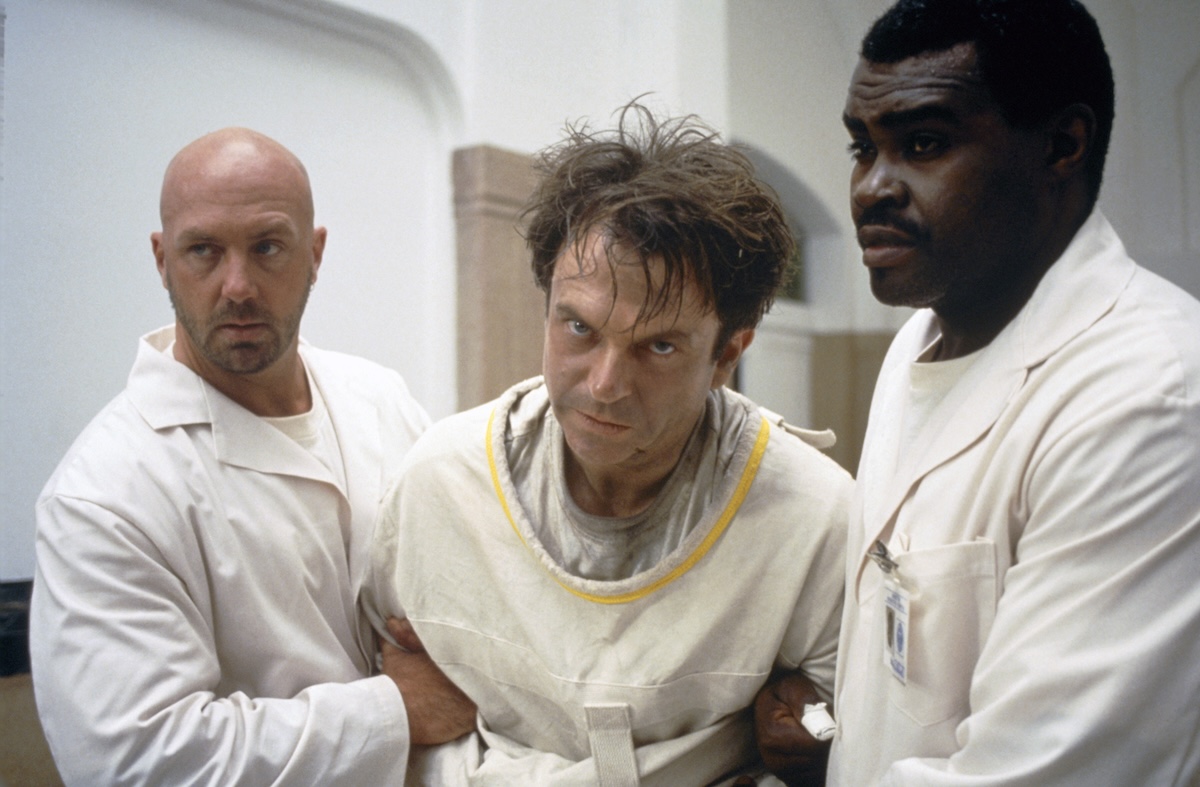
Said trilogy wasn’t a planned series of films by the director; the ‘Armageddon’ label came together retroactively once the three films had been released and were labelled by Carpenter fans and critics alike who all saw common themes involving cosmic horror and tragic endings. Another interesting observation/theory that was highlighted here is that the films explore different types of apocalypse, focusing on the loss of self, faith, and the very fabric of reality, rather than grand-scale destruction.
The Thing, of course, was Carpenter’s stunning remake of B-movie The Thing from Another World (1951). Whereas the original proved to be well made for its time, giving its audience plenty of action and thrills, the new version was quite a different beast, pardon the pun! Carpenter’s take was sombre, very scary, and contained horrific groundbreaking VFX. The second ‘Armageddon’ feature was Prince of Darkness. Starring Donald Pleasence, that film centres on a group of quantum physics students in Los Angeles who are enlisted by a Catholic priest to help investigate an ancient cylinder of mysterious liquid found in a monastery—only to discover that it’s a sentient, fluid manifestation of Satan. As daft as it sounds, this supernatural-themed tale makes for a far less satisfying watch compared to its predecessor, but overall it’s fine, and in recent years has achieved something of a cult-film status.
In the Mouth of Madness continues in an otherworldly vein and takes its title from the H.P. Lovecraft novella At the Mountains of Madness. Along with its title origins, the movie plays out with plenty of Lovecraftian themes: insanity, superstition, fate, religion—and there are also some hideous demonic creatures lurking in the shadows. Joh Trent (Sam Neill) is an insurance investigator hired by book publisher Arcane to find missing horror writer Sutter Cane (Jürgen Prochnow), along with the manuscript for his soon-to-be-published novel, also titled In the Mouth of Madness.
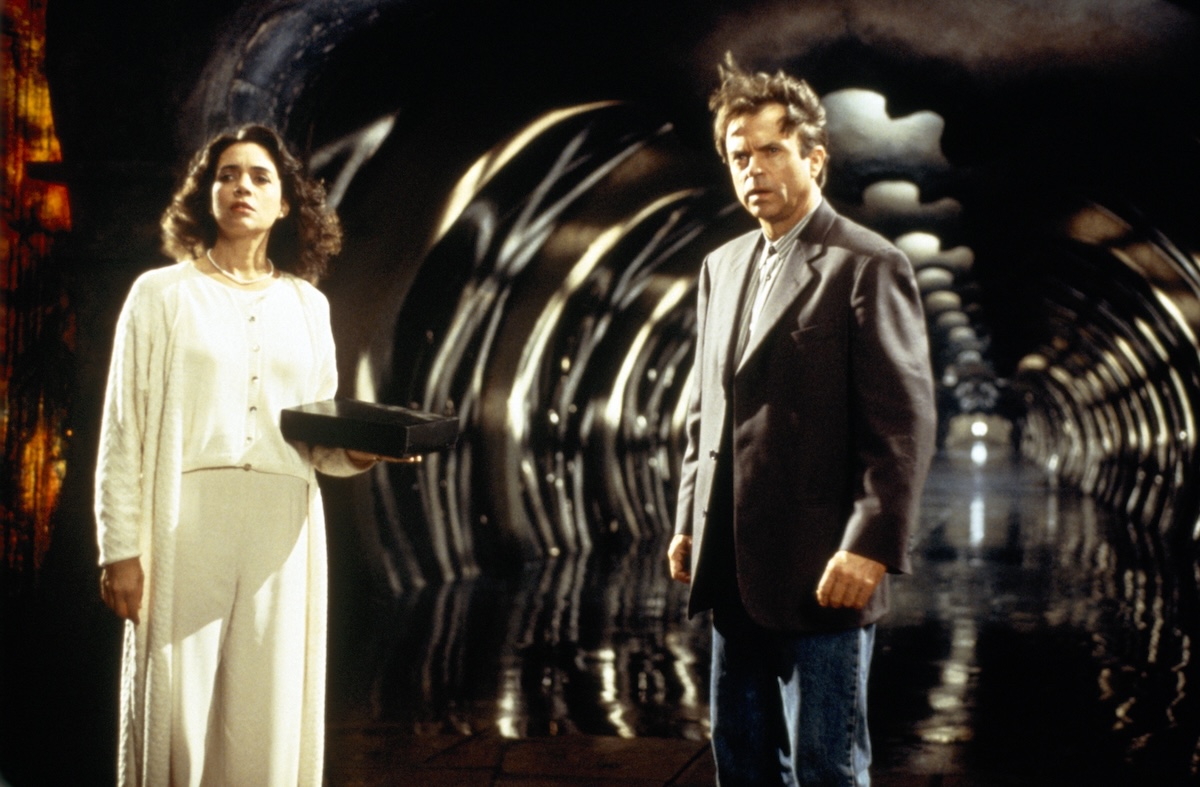
Arcane’s director, Jackson Harglow (Charlton Heston), assigns their editor, Linda Styles (Julie Carmen), to join Trent on his investigation. The investigator thinks the whole affair is some sort of elaborate PR stunt, but before long he and Styles find themselves in a nightmarish world that stretches their perception of what’s real and what’s not, which ultimately leads to Trent’s descent into insanity. If this all sounds a bit, well… mad, then I’m here to tell you you’re not wrong! In fact, it’s very mad, and for a movie that’s got madness in its title there can always be some creative leeway to go bonkers at times—which is fine if there’s a strong enough script to hold the film together into a cohesive whole, but that’s not the case here.
The first act of the film begins strongly enough. We see Neill’s Trent being admitted to a mental asylum. He’s clearly not well, at first behaving violently towards the orderlies when he’s first brought in, but once inside his padded cell he calms down and is soon visited by Dr Wrenn (David Warner). Trent tells Dr Wrenn that he’s now happy to be inside, as basically chaos reigns outside while the end of the world is starting to take place. Trent has also been drawing bizarre symbols in his cell, many of which appear to be of a religious nature. What does this all mean? Cut to the beginning of the story where Trent is discussing a potential new job with someone at a restaurant when, from across the street, we see some crazed man holding an axe burst out of the building opposite and start to make his way over to the exterior window of the eatery where, just on the other side, sits Trent. The man smashes the window with the axe and barges inside, standing over a cowering Trent. He says: “Do you read Sutter Cane?” Before he kills Trent, the police shoot him dead. As strange as this incident is, only moments before, the client was talking about Cane’s publishers wanting to hire Trent as their writer had gone missing.
This flashback narrative device has been used in films—and books—countless times as it’s usually effective for hooking in the audience, and in this instance it works perfectly well. So far, so good. The story kicks up a gear when Trent starts to read some of Cane’s books and they quickly begin to have some effect on him; he soon starts to have weird dreams or visions of a disfigured policeman beating someone up in an alleyway, just after he’s walked past an old poster advertising Cane’s upcoming book, The Hobb’s End Horror. What’s interesting here is that the movie’s core theme on fractured realities really takes shape, and this gains momentum when Trent works out the torn fragments of Cane’s novels form a map that points towards the fictional town called Hobb’s End. Trent and editor Styles head off to try and find out if there’s actually a place remotely resembling this town. Now things get even crazier as the film’s plot takes our two investigators into another plane of existence; one that’s utterly surreal and guaranteed to take your brain into a state of general befuddlement.
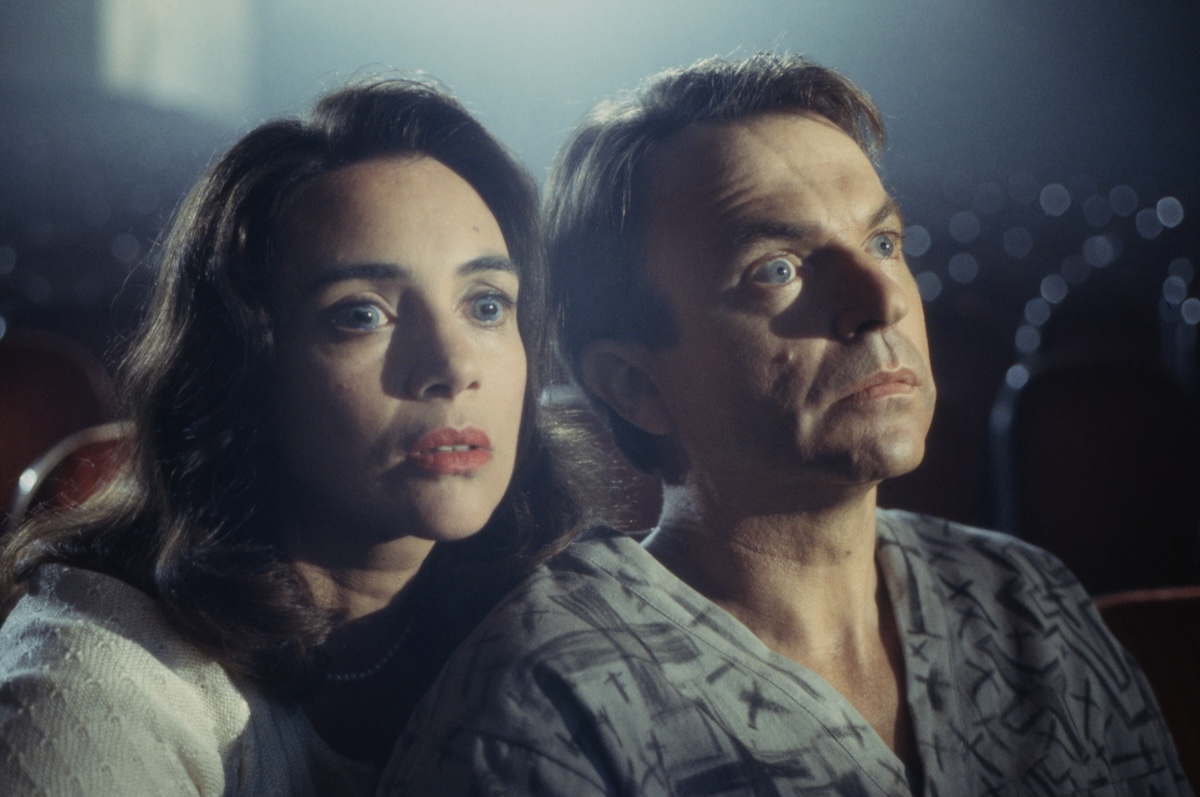
I like some mystery in a story as much as the next person, but when about 45 minutes in and you start to realise that the film is just not making any sense, one’s patience starts to wear thin. Once the two main characters enter Hobb’s End, the earlier part of the movie’s taut narrative structure gives way to a series of strung-together bizarre scenes that don’t really go anywhere. This may have been an intentional move to give its audience a sense of chaos and general disorientation, but for me, I was just left feeling somewhat lost and, dare I say it, even starting to get a little bored. Yes, there are some good ideas involving the power of belief, the fragility of reality, how art interacts with society—and there’s even a meta-contextual conceit at play—but all these thematic elements aren’t fully realised because of its uneven and messy script. It’s almost like the filmmakers were trying to cram everything in but their ambitions exceeded their creative grasp.
Perhaps I should say at this point that in no way do think this movie is terrible, or even unwatchable, quite the opposite actually. Despite its aforementioned shortcomings, there’s still much fun to be had here, and that’s mostly down to Sam Neill’s superb performance. His character arc from once sceptical know-it-all insurance investigator, to a deeply unhinged individual whose very notions of reality have crumbled away, is a joy to behold. Not once does he take the quick and easy road when portraying his progressing lunacy. This is a more subtle and nuanced take, and it happens gradually. Watching how his sane persona of bold arrogance and confidence slowly erodes into sheer terror and paranoia has to be the film’s main strength—by quite some margin. Okay, sure, the rest of the performances are fine, but the other cast members’ characters aren’t as strongly written as Neill’s, so no amount of good acting can fill in the blanks laid bare by the sadly lacking script.
Julie Carmen is perfectly solid as Cane’s publishing editor, but her personal journey is far from subtle, and the point in which her character’s story pivots is so rushed that it nearly derails the entire movie. And then there’s the dialogue which, at times, is so heavy-handed that it nearly crashes into camp territory; one scene that particularly comes to mind is when Cane is talking about being God, and it’s only because Jürgen Prochnow’s acting is so good that he saves the entire sequence from being unintentionally funny. When we finally meet Cane, he comes across as an almost cult-like figure; yes, he’s still on one level a writer—but now he’s been possessed by the evil nature of his work, and some of the townsfolk, including many of the children, have also become infected; one scene shows a group of youngsters chasing a three-legged dog through the town.
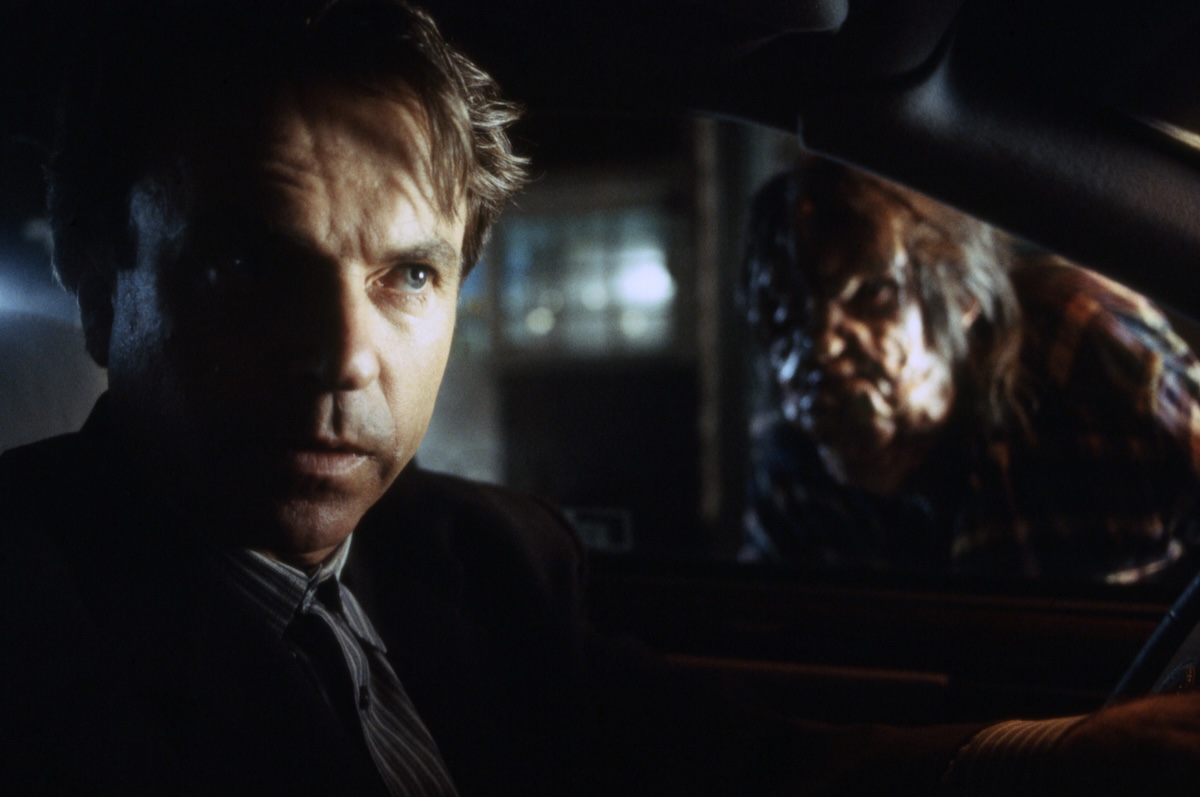
Coming from someone as accomplished a director as Carpenter, it’s not surprising to see that his direction is of a high standard; all of which proves to be most effective when shooting the scenes in Hobb’s End and he’s conveying a world that’s not quite right, a reality that kind of looks like ours, but once scratched beneath the surface is anything but. There’s an atmosphere of quiet dread and menace that wouldn’t be out of place in a David Lynch film. Cinematographer Gary B. Kibbe makes full use of his 22mm wide-angle lens and deep focus to show off this nightmarish landscape, and the Canadian locations of Toronto and Ontario look suitably atmospheric; particularly the real-life Cathedral of the Transfiguration that stands in as the film’s Black Church. One other technical merit that’s worth mentioning are the film’s practical Lovecraftian monster effects by KNB EFX Group which are pure nightmare fuel that resemble something from Clive Barker’s Hellraiser (1987).
When released at the end of 1994, In the Mouth of Madness didn’t make much of a splash. It barely made back its $8.9M budget, and critics were divided; Roger Ebert gave the film two out of four stars, saying that the film has an intriguing premise, but squanders it by relying on hackneyed jump scares and gore; honwever, Kevin Thomas of the Los Angeles Times called it “a thinking person’s horror picture that dares to be as cerebral as it is visceral”. My own personal feelings veer somewhere between these two viewpoints. It has plenty of interesting things to say, about one’s perception of reality and the notion that stories can literally reshape the world, but these ideas are never fully fleshed out, and the overall experience is something of a frustrating hot mess. It’s a film that can’t quite decide what it is: a major horror film with complex themes running through its core, or merely a B-movie schlock-fest. Maybe Carpenter’s aim was to find a happy medium of the two, but something got lost on the cutting room floor.
Over the years, the film has, like many of his past features, found a loyal following. As Carpenter’s status as a cult filmmaker grew in the 2000s, In the Mouth of Madness was rediscovered and appreciated in a new light. Modern audiences and film scholars have even gone on to say how ahead of its time it really was: concluding its story is about a world addicted to media that’s unable to tell fact from fiction. I’m not convinced this was Carpenter’s original thought-process, but viewed in today’s world of conspiracy theories and online misinformation, I can certainly see how these conclusions have come about. In any case, what I am sure of is that this film is definitely worth a watch. It’s rare these days to find a movie that is chock-full of so many ideas and bizarre imagery, and has clearly been made by a ton of very talented people, that to dismiss and ignore it would do it a great disservice—so find time and embrace the madness!
USA | 1994 | 95 MINUTES | 2.35:1 | COLOUR | ENGLISH


I watched Arrow Video’s new 4K Ultra HD Blu-ray presentation and found the picture quality to be pin-sharp, with its vibrant colours and darkest contrast looking rich and perfectly balanced. Taken from its original 35mm camera negative, this restoration has quality pouring out of every one of its frames. Even when there are night-time scenes, or jet-black backgrounds, you’ll not see any hint of pixelation—in fact, compared to when I last watched this film via streaming some years ago, the difference in terms of overall viewing experience is, to put it mildly, massive.
The sound quality is also first-rate. You can switch between its original DTS-HD MA 5.1 output, or choose the stereo 2.0 audio option. Whatever you decide, the sound reproduction coming off this disc is crisp and clear, and even with the volume turned up high, you will not get close to any type of distortion. Carpenter and Jim Lang’s score probably has not sounded this good in decades.

director: John Carpenter.
writer: Michael De Luca.
starring: Sam Neill, Julie Carmen, Jürgen Prochnow, Charlton Heston, David Warner, John Glover, Bernie Casey & Peter Jason.
